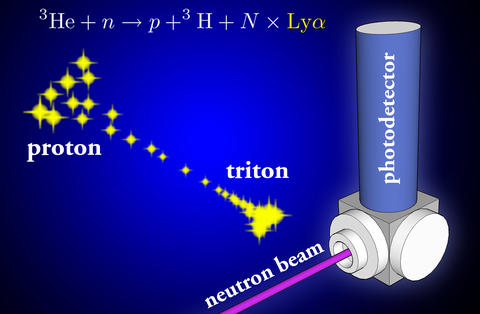
Neutron absorption by 3He yields tens of Lyman alpha photons, which result from the most fundamental energy jump in the hydrogen atom. This schematic illustrates the operation of a prototype Lyman alpha neutron detector (LAND).
Researchers at the National Institute of Standards and Technology (NIST) and the University of Maryland have developed a new optical method that can detect individual neutrons and record them over a range of intensities at least 100 times greater than existing detectors. The new detector, described at the March Meeting of the American Physical Society by Charles Clark, a Fellow of the Joint Quantum Institute of NIST and the University of Maryland, promises to improve existing neutron measurements and enable tests of new phenomena beyond the Standard Model, the basic framework of particle physics.
The prototype laboratory device is based on a process first observed by the research team: the emission of light from hydrogen atoms produced when neutrons are absorbed by helium-3 atoms (3He). Lyman alpha light, discovered by Harvard physicist Theodore Lyman in 1906, results from the jump between the two lowest-energy states of the hydrogen atom. Although it is the brightest light emitted by the sun and is one of the most abundant forms of light in the universe, Lyman alpha is invisible to the eye because it lies in the far ultraviolet region of the optical spectrum. It is strongly absorbed by most substances and can travel through only about a millimeter of air.
Helium gas, however, does not absorb Lyman alpha light. When a neutron is absorbed by a helium-3 atom, one atom of hydrogen and one atom of tritium (a heavy form of hydrogen) are produced. These atoms fly apart at high speeds, can be excited by collisions with surrounding helium gas, and subsequently emit Lyman alpha light. This light is recorded by the new device, known as the Lyman alpha neutron detector (LAND).
Using an ultracold neutron beam at the NIST Center for Neutron Research, the research team has discovered that Lyman alpha light is generated with surprisingly high efficiency: about 40 photons are generated per neutron for helium gas at atmospheric pressure. According to Alan Thompson, neutron expert on the team, "This device thus has the potential to detect both single neutrons and large numbers of neutrons, which is very difficult to do with present neutron detectors based on electrical discharges."
The use of an optical means of detection, rather than an electronic one, also offers the prospect of at least a hundredfold improvement in neutron detectors' dynamic range (the spread in recordable neutron intensity from faint to bright). This stems from the fact that optical detectors respond more quickly than electronic detectors, which suffer from longer periods of inactivity known as "dead time."
With further development, this new method can potentially lead to better measurements at existing neutron facilities (for example, neutron diffraction instruments at the NIST Center for Neutron Research) and enable new tests of physics beyond the Standard Model. Measurements at NIST of a property in neutrons known as the electric dipole moment and more precise measurements of the neutron lifetime are planned.
C. W. Clark, A. K. Thompson, M .A. Coplan, J. W. Cooper, P. Hughes and R. E. Vest, Observation of the n(3He,t)p reaction by detection of far-ultraviolet radiation. Presented at the 2008 March Meeting of the American Physical Society, New Orleans, La., March 10-14, 2008. paper B14.00010.

